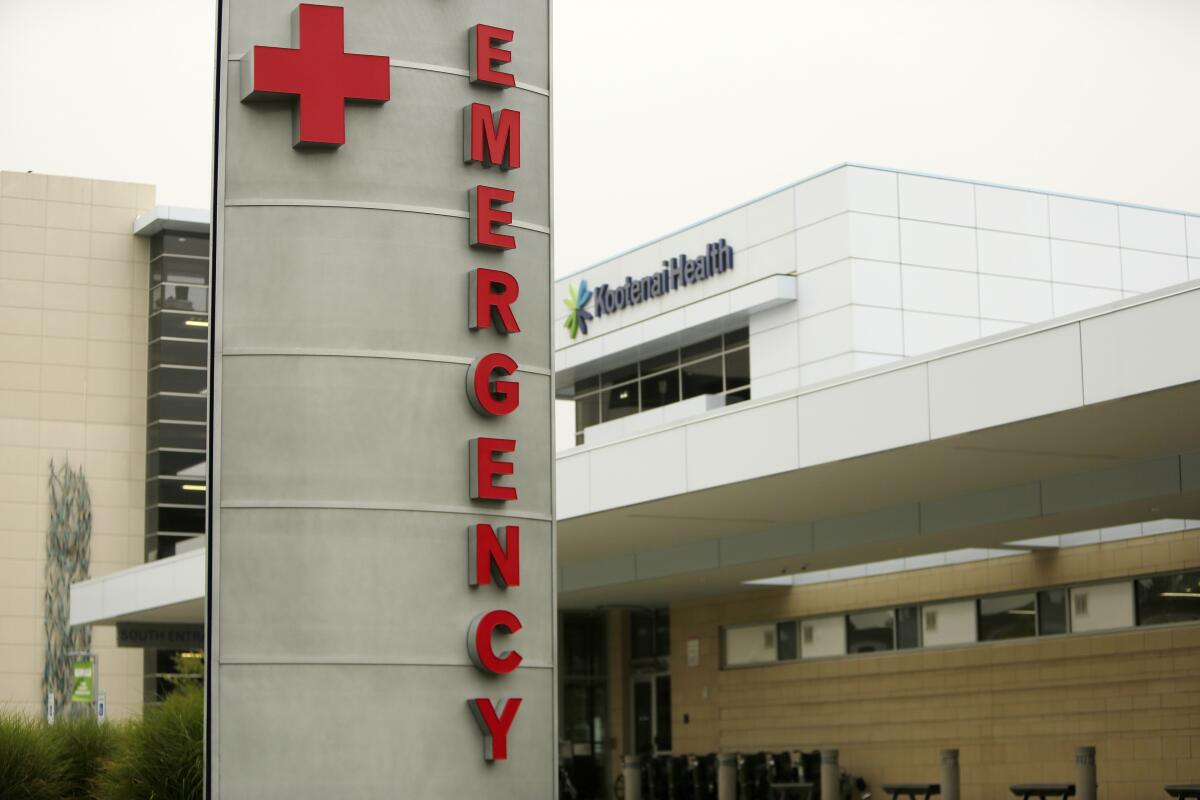Idaho rations healthcare statewide amid massive COVID-19 surge

- Share via
BOISE, Idaho — Idaho public health leaders on Thursday expanded healthcare rationing statewide amid a massive increase in the number of coronavirus patients requiring hospitalization.
The Idaho Department of Health and Welfare made the announcement after St. Luke’s Health System, Idaho’s largest hospital network, on Wednesday asked state health leaders to allow “crisis standards of care” because the increase in COVID-19 patients has exhausted the state’s medical resources.
Idaho is one of the least vaccinated U.S. states, with only about 40% of its residents fully vaccinated against COVID-19. Only Wyoming and West Virginia have lower vaccination rates.
Crisis care standards mean that scarce resources such as intensive care unit beds will be allotted to the patients most likely to survive. Other patients will be treated with less effective methods or, in dire cases, given pain relief and other palliative care.
Thursday’s move came a week after Idaho officials started allowing healthcare rationing at hospitals in northern parts of the state.
Northern Idaho has a long and deep streak of anti-government activism that is confounding attempts to battle a COVID-19 outbreak.
“The situation is dire — we don’t have enough resources to adequately treat the patients in our hospitals, whether you are there for COVID-19 or a heart attack or because of a car accident,” Idaho Department of Welfare Director Dave Jeppesen said in a statement.
He urged people to get vaccinated and wear masks indoors and in crowded outdoor settings.
“Our hospitals and healthcare systems need our help,” Jeppesen said. “The best way to end crisis standards of care is for more people to get vaccinated. It dramatically reduces your chances of having to go to the hospital if you do get sick from COVID-19.”
One in every 201 Idaho residents tested positive for COVID-19 over the last week, according to a tally by Johns Hopkins University. The mostly rural state ranks 12th in the U.S. for newly confirmed cases per capita. More than 1,300 new coronavirus cases were reported to the state on Wednesday, according to the Idaho Department of Health and Welfare.
Hospitalizations have skyrocketed. On Monday, the most recent data available from the state showed that 678 people were hospitalized statewide with the coronavirus.
Idaho public health leaders are letting the state’s northern hospitals ration healthcare because there are more COVID-19 patients than the institutions can handle.
Meanwhile, the number of COVID-19 patients in intensive care unit beds has stayed mostly flat for the last two weeks at 70 people each day — suggesting the state may have reached the limit of its ability to treat ICU patients.
Though all of the state’s hospitals can now ration healthcare resources as needed, some might not need to take that step. Each hospital will decide how to implement the crisis standards of care in its own facility, public health officials said.
Kootenai Health in the city of Coeur d’Alene was the first hospital in the state to officially enter crisis standards of care last week.
At the time, Chief of Staff Robert Scoggins said some patients were being treated in a conference center that had been converted into a field hospital. Others received treatment in hallways or in converted emergency room lobbies. Urgent and elective surgeries are on hold across much of the state.
On Wednesday, nearly 92% of all of the COVID-19 patients in St. Luke’s hospitals were unvaccinated. Sixty one of the hospital’s 78 ICU patients had COVID-19. St. Luke’s physicians have pleaded with Idaho residents for months to get vaccinated and take steps to slow the spread of the coronavirus, warning that hospitals beds were quickly running out.
Public health officials have warned Idaho residents for weeks to take extra care to ensure they don’t end up in hospitals. Last week, Jeppesen said residents should take their medications as prescribed, wear seatbelts and reconsider participating in any activities such as cycling that could lead to injuries.
The healthcare crisis isn’t just affecting hospitals — primary care physicians and medical equipment suppliers are also struggling to cope with the crush of coronavirus-related demand.
One major medical supplier, Norco Medical, said demand for oxygen tanks and related equipment has increased, sometimes forcing the company to send patients home with fewer cylinders than they would normally provide. The company is also asking people to return unused or unneeded oxygen tanks so they will have enough on hand for the surge.
“There is a limit to everything. My leadership team and I were actually discussing this and we certainly all agreed that the word we’d like to use right now is that things are getting tight,” Norco President Elias Margonis told Boise television station KTVB. “The concern is how much tighter will it get.”
Primary Health Medical Group, Idaho’s largest independent primary care and urgent care system, late last month was forced to shorten operating hours because its waiting rooms were so packed with patients that staffers were staying hours past closing in order to see them all. Meanwhile, the company was dealing with higher-than-normal numbers of staffers out sick because they had been exposed to the coronavirus in the community or had symptoms and were awaiting tests. Vaccination provides strong protection against becoming seriously ill with the coronavirus, but the highly contagious Delta variant can still cause breakthrough cases in vaccinated people.
As case numbers continued to increase, some of Primary Health Medical Group’s 21 clinics in southwestern Idaho have had to stop operating on weekends or close certain days of the week, said Chief Executive David Peterman.
Now the medical group is also preparing to monitor its patients who are released earlier than they normally would be from the hospital after emergencies, Peterman said.
“We will see more visits with patients that are avoiding the emergency room and patients who are sicker and need more care,” Peterman said. “We are setting up a system right now to make sure over this weekend that we are immediately notified if one of our patients is discharged early from the hospital so we can make sure those patients are OK.”
Resources have been exhausted across the medical system, Peterman said.
“This is heart-wrenching. I’ve practiced medicine in southwest Idaho for 40 years and I have never seen anything like this,” he said. “I feel for the doctors and the nurses and the staff in the hospital who are making very difficult decisions.”
More to Read
Sign up for Essential California
The most important California stories and recommendations in your inbox every morning.
You may occasionally receive promotional content from the Los Angeles Times.












